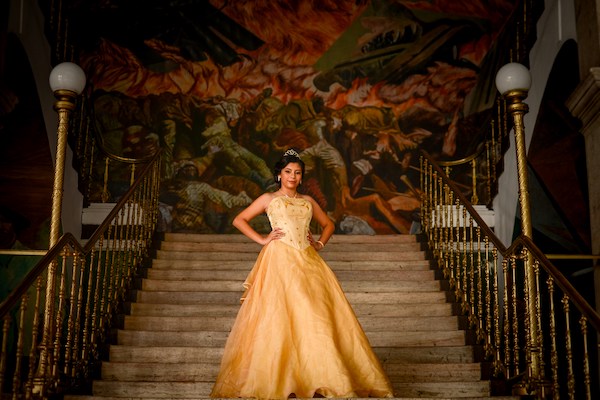Quinceañeras hold profound cultural significance within the Latinx community, as the event celebrates the transition from girlhood to womanhood. Leading up to my 15th birthday, I took an untraditional approach to this staple event in my culture.
My name is Victoria F. Vega, and I am a proud Latina with roots tracing back to Puerto Rico and Uruguay. Now, picture this: it’s the eve of my 15th birthday, and the air is buzzing with anticipation for my quinceañera. But here’s the twist — my journey to womanhood is about to take a detour through Queer Street, and I don’t even know it yet!
Preparing for the big day
Growing up in Miami, FL, the idea of a traditional quinceañera was practically woven into the fabric of my adolescence. I danced competitively my whole life, and all of the girls around me were constantly planning their “quinces” (a shortened term for quinceanera). Everyone talked about the boy they’d pick as their partner for their court (quinceañera celebrations, similar to debutante balls, consist of a court of couples performing formal partner dances — the pairs always consist of a boy and a girl). But as I got closer to that big milestone, I realized something: this celebration was about more than just fancy dresses and formal dances. It was about reclaiming my identity on my own terms, even if I didn’t fully grasp what that meant yet.
Right off the bat, I knew my quinceañera would break the mold. Forget the whole “quince court” scene — that was not my vibe. Instead, I didn’t have a court. I opted to celebrate the milestone with friends and loved ones from all walks of life, regardless of identity.
It was 2015, and I had no clue my plans were so queer-coded and feminist. I didn’t know that I was queer, and I was not yet equipped with the terminology or knowledge to unpack the patriarchal nuances of a quinceañera. I simply didn’t engage in the patriarchal traditions because “it wasn’t me” and “it felt weird” at the time. Talk about smashing the heteronormative patriarchy without even knowing, am I right?
Reimagining traditions
The grand entrance plays a large role, solidifying the formality and debutante nature of a quinceañera. Of course, I wasn’t going to have some guy escorting me into my own party. I walked in all by myself, in my non-traditional gown wearing a princess tiara that my grandma made, soaking up all of the attention for myself. I grew up in a family of empowered women, and if I learned one thing, it was that I didn’t need a man to live my life. So breaking the tradition of being escorted in by some 15-year-old boy who didn’t even know how to shave yet was accepted by my family.
As for the father-daughter dance? Yeah, that wasn’t happening either. That whole “daddy’s little girl” shtick just didn’t sit right with me. I love my father to death, but the traditional dance just felt strange, so I opted for both of my parents to give individual speeches. I was all about rewriting those moments to reflect my own sense of independence and autonomy.
My mom and older sister played a huge role in my quinceañera. They supported every idea I had and never forced me to fit into the box of what a girl was expected to be, nor did they pressure me to follow tradition.
Next, let’s talk about fashion. None of those over-the-top debutante dresses for me. Traditionally, quince dresses are white, mimicking the look of a wedding dress. I found this weird, considering a quince a 15-year-old’s birthday party. I opted for a fabulous floral and rhinestone gown that screamed confidence and sophistication. Oh, and did I mention I had a quick change into a shorter party dress with a tulle skirt? That was my way of saying “adios” to society’s rigid expectations of femininity.
There are many quince traditions that celebrate the birthday girl “becoming a woman” at the young age of 15. Originally, quinceañeras were intended to showcase a young girl’s purity and her readiness for marriage. Through this hypersexualized lens, a major tradition related to the milestone is the birthday girl’s gifting of a doll to a younger sister or cousin as a means of symbolizing that the birthday girl is stepping away from girlhood.
Another tradition often performed at the celebration is changing from flats to heels, which symbolizes the birthday girl’s transition to womanhood. However, all of that felt weird to me, so I did not partake in any of it.
Venue-wise, I ditched the stuffy ballroom in favor of a space decked out in pop art and colorful sculptures. Because why would I try to keep the setting traditional when I’ve already veered so far from society’s expectations of this celebration?
And let’s not even get started on the food — no formal sit-down dinner for me. Instead, I went all out with a live chef cooking station and a spread of all of my favorite foods. I had short rib empanadas, a pasta station, Krispy Kreme donuts, a cream puff tower, and more!
Embracing Authenticity
At its core, my non-traditional quinceañera was a big ol’ middle finger to patriarchal norms. I mean, why should I conform to society’s outdated gender roles and expectations? Spoiler alert: I shouldn’t, and neither should you.
Looking back, my quinceañera wasn’t just a celebration of me turning 15. It was a declaration of self-acceptance and authenticity. It was my way of saying, “This is who I am, and I’m damn proud of it.” So here’s to embracing our identities, challenging the status quo, and throwing the most badass quinceañera the world has ever seen.


